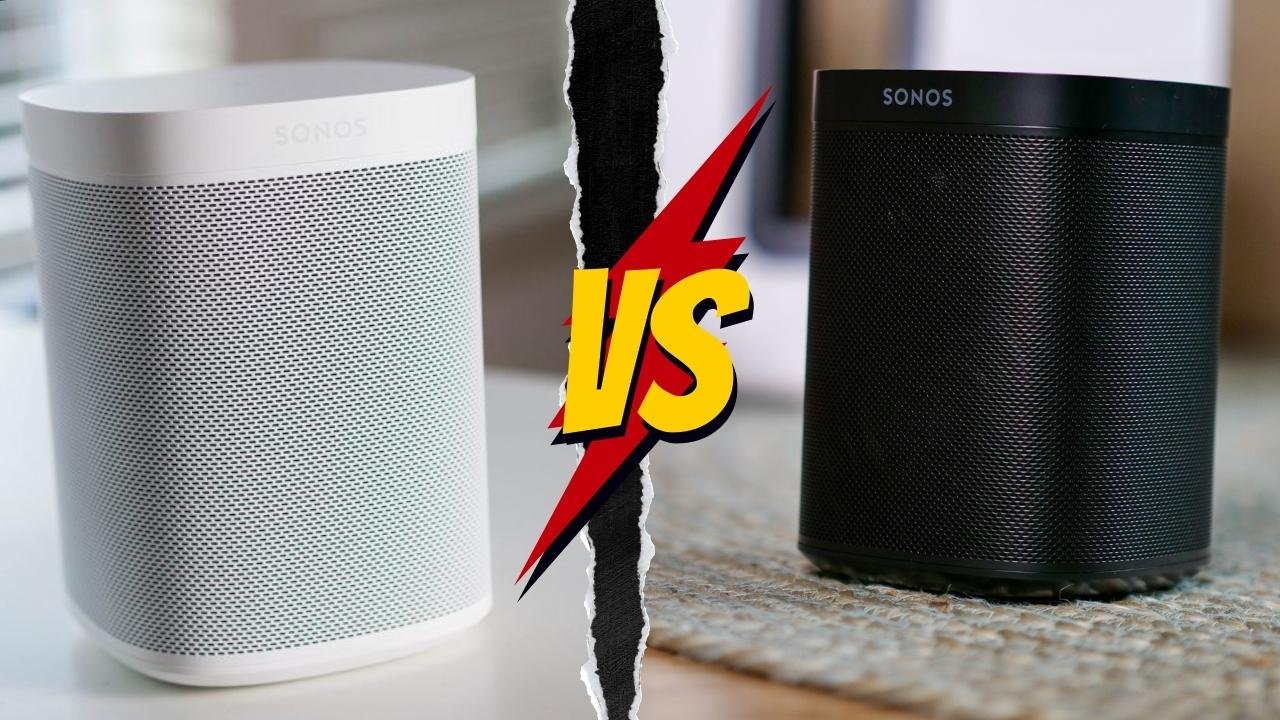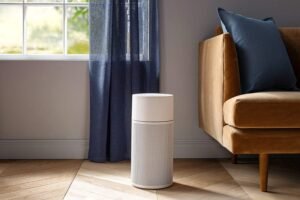
In terms of smart speakers, Sonos is currently a top brand. In order to help you choose which Sonos speaker is best for you, we’ll compare the Sonos One and Sonos One SL, which the company recently released.
| Sonos One (Gen 2) | Sonos One SL |
 |  |
| BUY NOW | BUY NOW |
| PROS | PROS |
| + Bass and treble sliders via companion app. + Decent directivity. + Supports Alexa and Google Assistant. + Can be connected to Sonos soundbars as surround speakers. | + Compatible with Sonos soundbars. + Bass and treble adjustments. + Clear vocal reproduction. |
| CONS | CONS |
| – Struggles to get loud and compression artifacts at max volume. – stereo content into mono. – No audio streaming via Bluetooth. | – No Bluetooth support. – Downmixes stereo content into mono. – Not very portable. |
Sonos One (Gen 2) VS One SL: Specs
| Category | Sonos One (Gen 2) | Sonos One SL |
| RGB Lights | No | No |
| Weight | 4.0 lbs (1.8 kg) | 4.0 lbs (1.8 kg) |
| Power Source | AC Only | AC Only |
| One-Hand Carry | Yes | Yes |
| Water Resistance | No | No |
| Dust Resistance | Unspecified | No |
| Music Play/Pause | Yes (Tactile) | Yes (Tactile) |
| Call Answer/End | No | No |
| Volume Up/Down | Yes (Tactile) | Yes (Tactile) |
| Voice Assistant | Yes | No |
| Bluetooth | No | No |
| Wi-Fi | Yes | Yes |
Price & Availability
The Sonos One gen 2 is a $219 smartspeaker from Sonos that supports Apple’s Airplay 2 protocol, the Google Assistant, Alexa, or Sonos’s own voice control assistant and has a premium build and design. Most importantly, it has amazing sound. The Sonos One SL is one of the company’s more reasonably priced connected speakers, allowing you to enter the Sonos ecosystem of devices. However, it still needs to be made affordable.
Unlike the One, the One SL is $20 less expensive at $199 and lacks microphones and native voice assistants. If you don’t require or intend to use voice assistants in your Sonos device, you can save some money by switching to the One SL, which shares the same functionality aside from the absence of microphones and voice assistance.
Sonos One (Gen 2) VS One SL: Design
1. Sonos One (Gen 2)

Let’s start by discussing design. The Sonos One is well-built, feels premium, and has some weight to it. It also has a nice aesthetic and should fit in with your home thanks to its straightforward design. The touchscreen controls for the device are located at the top. Over the past six months, the controls have been reliable, and I love how Sonos created the Sonos One (Gen 2).
You slide across the top between the volume buttons to skip forward and backward. There is also a mute mic button, play/pause, and volume control buttons.
The main advantage of getting a Sonos One (Gen 2) is its sound. It outperforms every other smart speaker I have tested, including the amazon echo, apple homepod mini, nest audio, nest hub max, etc. Another great feature of its design is that Sonos One (Gen 2) is designed with high-humidity environments in mind, so you can place one in a bathroom to listen to music.
2. Sonos One SL

The One SL is available in white and black and has a matte plastic and metal design that looks contemporary and minimal. A metal speaker grille surrounds the entire speaker, concealing and protecting the two forward-facing speaker drivers, while a plastic finish covers the top. I do like how the one with the One SL looks. With dimensions of just over six inches tall, just over four and a half inches deep, and just over four and a half inches wide, it is simple, understated, functional, and easy to integrate into the home.
The One SL’s top plastic area houses the only physical interface with the speaker. On the top of the speaker are three touch buttons that let you change the volume, skip tracks, and play in ports. Tracks can be skipped with a simple swipe across all three buttons. This keeps the top of the speaker looking neat and organized.
Although numerous other status colors and patterns are described on the Sonos website, the top of the speaker also has a status light that can indicate whether the speaker is turned on, connected, or muted.
Instead of using wi-fi, you can connect the speaker to a physical network using the ethernet port on the back of the device. There is also a join button for speaker reset. The speaker is primarily empty aside from a right-angled figure-eight power cable that plugs into the bottom of the device; the Sonos app is used to set up and control the speaker’s other features. You will notice that the One SL does not have a power button because it is always intended to be on and connected.
Sonos One (Gen 2) VS One SL: Sound Quality

The Sonos One (Gen 2) is the speaker I prefer to use over all other smartspeakers I own because it produces a very crisp, detailed sound that is enjoyable to listen to and has a surprising amount of bass, given its size. During my time using the One SL, it was tuned to the room using Sonos’s true play feature, which is regrettably only available on the iOS version of the Sonos app. The One SL offers an awe-inspiring listening experience.
Utilizing this feature is highly recommended because TruePlay analyses how the speaker’s sound reflects off objects in the room and adjusts the speaker to produce a sound appropriate for the environment. Considering that only one speaker produces mono sound, the One SL also has a good range of volume settings. Playback can be very quiet on its lower settings, but it can also handle the volume if you turn it up and fill the room with sound.
Sonos One (Gen 2) VS One SL: Pairing Devices

The Sonos 1 can be grouped with other AirPlay 2 speakers you own because it supports Apple’s AirPlay 2 standard, which is a great feature. It’s very easy to pair two Sonos speakers in the app, which improves the sound stage. Additionally, the app allows you to group together several Sonos speakers in a single room.
You can pair two One SL speakers to make a stereo pair if you’d like, but the sound stage is impressive and TruePlay does play a significant role with One SL. Of course, you can change the EQ from the Sonos app if you prefer.
Sonos One (Gen 2) VS One SL: TruePlay

The TruePlay feature of Sonos, which can be found in the Sonos app, contributes to the incredible sound that Sonos speakers produce. TruePlay is an audio tuning feature that helps your Sonos One (Gen 2) balance its sound output based on the size of your room and where you’ve placed your speakers.
Once you’ve set up all of your speakers, the Sonos app uses the microphones on your phone to gather information about your room as your Sonos One emits a semi-loud sound, but the result is that your speaker or speakers will sound way, way better if you use TruePlay.
Sonos One (Gen 2) VS One SL: Sonos App

One of the main ways to control Sonos One right now is through the Sonos app. One of the cool things Sonos did with their app is making it incredibly simple to connect to your favorite music streaming services so you can play them on your Sonos devices. Not just well-known services like Spotify, Apple Music, YouTube Music, Amazon Music, Pandora, Deezer, and TuneIn are available to them. The One SL is primarily controlled through the Sonos app.
You must all use the same account on your network, though, as a Sonos device cannot be shared among different accounts in the same home.
You can also connect to websites like Pocketcasts for podcasts, Libby for listening to audiobooks you borrowed from the library, Audible, and many others. In addition, Sonos offers a free radio feature with ads and includes live radio stations like NPR and BBC. You can also upgrade to an HD version for $799 per month to get an ad-free experience with unlimited skips and lossless quality.
Sonos One (Gen 2) VS One SL: Voice Assistants

As was already mentioned, the Sonos One SL does not have the voice assistants that can be installed on Sonos speakers to play and control media. Unfortunately, the assistants you can run on the Sonos One need to be more up to parity with competing speakers from google and amazon. The google assistant, which I’ve used on the Sonos One as my primary assistant for the past six months, actually works quite well.
Now, the Sonos One will correctly play something after the original song you requested if you use either assistant to play Spotify. Additionally, for the google assistant specifically, the Sonos One will dim its volume after you request a song so the assistant can keep listening for a subsequent request. However, it frequently does this for too long, making it easy to be misled into thinking the volume is turned way down, so you’ll turn it up only to be shocked by the increased volume.
Additionally, the Google Assistant plays music on the Sonos One much more slowly than Alexa or Sonos’s own voice control feature.
Sonos One (Gen 2) VS One SL: Sono’s Voice Control

Sono’s Voice Control uses the onboard microphones of the Sonos One to control your music and Sonos system without using Google or Amazon to process your voice data. It’s a stupid limitation put in place by Google, not Sonos, that prevents you from using the Google Assistant on the Sonos One and Sonos’ voice control simultaneously. Thankfully, Amazon doesn’t put such restrictions in place so that you can simultaneously use Alexa on the device and Voice control.
You can’t currently use Sono’s voice control to play music from YouTube or Spotify. It also has a problem where when you ask Sonos to play a song, it only plays that song and nothing else. However, you can use Sono’s Voice Control to play and pause media on a group of airplay speakers that includes a Sonos One. You can’t use Sono’s Voice Control to group in other airplay 2 speakers as you can with Siri on Apple’s Homepod mini.
Conclusion
There is no denying the user experience is significantly and negatively impacted after six months of use with the Sonos One (Gen 2) system. However, the Sonos One SL is a fantastic connected speaker for your home that looks and sounds great. It has ios-centric features like trueplay and if that doesn’t concern you and you’re looking for something that works once it’s all set up, the One SL is a great way to enter the Sonos world. However, if you’re looking for something that works immediately after it’s been set up, the One SL is a great alternative.




